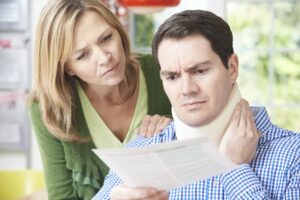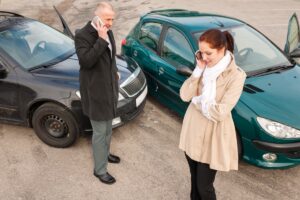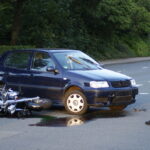Immediately after the accident, especially if you’re injured, call 911. Get the ambulance to come out immediately. It sounds like common sense, but it’s not always followed. Call 911, get the ambulance, and hopefully they’ll come with a police officer who can do a traffic collision report.
Hopefully, if a police officer comes to the scene they can get a lot of information from you and the others involved. Often, though, if it’s not a severe injury, a police officer will refuse to come to the scene. In that case, you’ve got to exchange information on your own.
If you’re not too severely injured, you should try to exchange information (which is required by law.) You should exchange your driver’s license number, your name, your contact information, and your insurance information with the other parties involved in the accident.
Take pictures. Take lots of pictures and document everything as well as possible. Write down what you’re experiencing and what happened. Use the camera on your phone if nothing else, and take as many photos as you can. Take photos of bruises, cuts, scrapes, etc. – the types of things that may heal later on.
Also, take lots of pictures of vehicles so you can show what the damages are. Your car and the other car or cars as well. Lots of times, people will get their cars fixed right away and they’ll refrain from taking pictures, and that can be a big mistake. Also take pictures of any skid marks in the road, any debris that may have come off of the cars involved, and that type of thing.
Take pictures of all the license plates of all the cars involved. This will be especially helpful if one of the drivers involved in the accident flees the scene.
Take pictures of the license plates of any witnesses so that you might be able to go back and find them if they somehow disappeared without leaving their information. Don’t rely on the police officer to get witness information—get all the contact information you can. Witnesses can be a make-it-or-break-it for your case.
The most important thing is going to be taking care of your injuries, but if you can remember to have your loved ones, or the people that are there taking care of you, take pictures of your injuries at the scene or in the hospital, that could only help your case from a legal perspective.
Those initial photographs in the ER and then the hospital room can really go a long way to getting your case settled, or convincing a jury how badly injured you were on the day of the accident.
Be very, very careful about making statements at the scene. Later on, often what will happen is each party will say the other party admitted fault for the accident. You do not want to admit the fault at an accident scene. If the other side is agreeing that it’s their fault, maybe you can get them to put that on a recording if you ask their permission to record the statement.
Be very careful having anything to say to the other party other than “these are my injuries and this is my contact information.” If you get involved in a discussion with somebody else at the scene, somehow they might have a way later, at trial, or in a deposition, of saying that the discussion was all about how you were at fault.
You might not have said anything about fault but they’ll come back and say, “Hey, you told me at the scene, we talked for half an hour that it was your fault.” If there’s no discussion, it’s much easier to disclaim that.







